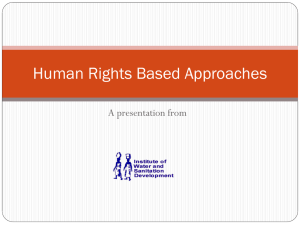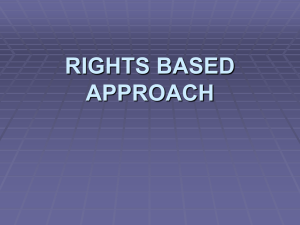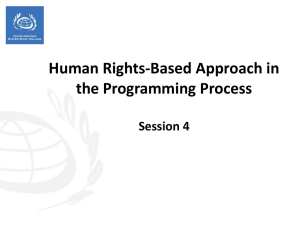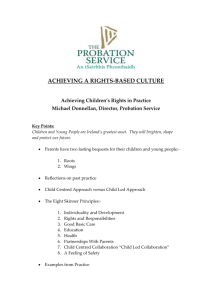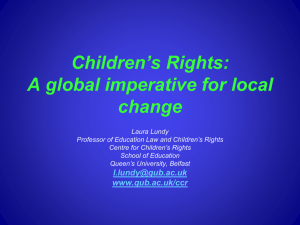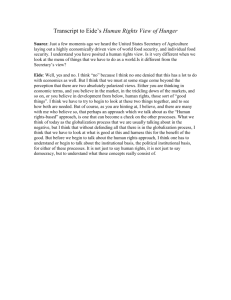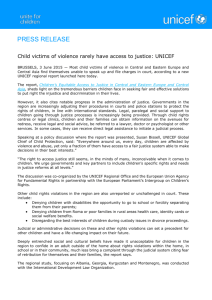Rights-based approaches
advertisement
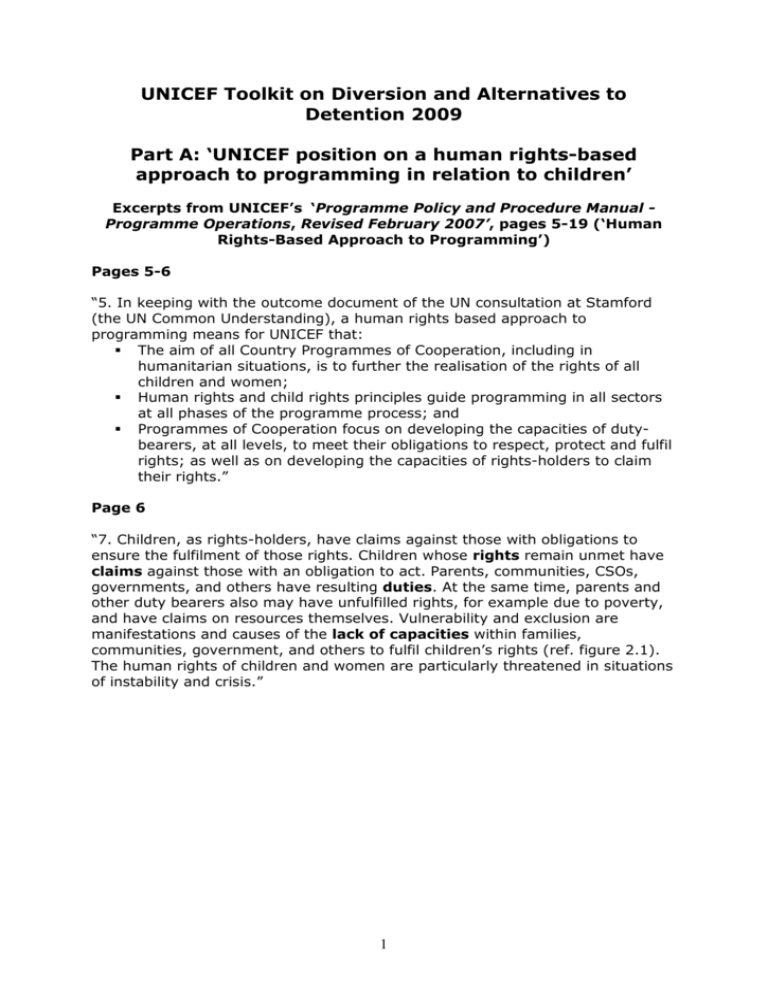
UNICEF Toolkit on Diversion and Alternatives to Detention 2009 Part A: ‘UNICEF position on a human rights-based approach to programming in relation to children’ Excerpts from UNICEF’s ‘Programme Policy and Procedure Manual Programme Operations, Revised February 2007’, pages 5-19 (‘Human Rights-Based Approach to Programming’) Pages 5-6 “5. In keeping with the outcome document of the UN consultation at Stamford (the UN Common Understanding), a human rights based approach to programming means for UNICEF that: The aim of all Country Programmes of Cooperation, including in humanitarian situations, is to further the realisation of the rights of all children and women; Human rights and child rights principles guide programming in all sectors at all phases of the programme process; and Programmes of Cooperation focus on developing the capacities of dutybearers, at all levels, to meet their obligations to respect, protect and fulfil rights; as well as on developing the capacities of rights-holders to claim their rights.” Page 6 “7. Children, as rights-holders, have claims against those with obligations to ensure the fulfilment of those rights. Children whose rights remain unmet have claims against those with an obligation to act. Parents, communities, CSOs, governments, and others have resulting duties. At the same time, parents and other duty bearers also may have unfulfilled rights, for example due to poverty, and have claims on resources themselves. Vulnerability and exclusion are manifestations and causes of the lack of capacities within families, communities, government, and others to fulfil children’s rights (ref. figure 2.1). The human rights of children and women are particularly threatened in situations of instability and crisis.” 1 Page 7 “8. UNICEF cooperation at country, regional and global levels: a. assists and builds the capacities of governments and civil society to continuously assess and analyse the situation of children and women in relation to the Human Rights instruments of the UN system, especially the CRC and CEDAW (particularly in relation to UNICEF’s organizational priorities); to identify the most marginalized whose rights remain unfulfilled; and to understand the immediate, underlying and basic causes for this situation. UNICEF facilitates deeper analysis through sharing of global experience, evaluations and lessons learned and support to a research agenda; b. helps to articulate the claims of poor, marginalized children and women, and to draw attention to their rights through advocacy with decision makers or through social mobilisation. UNICEF contributes through its inherent multilateral character, reflecting global consensus and authoritative statements on children’s rights; and helps to strengthen c. accountability mechanisms and local and national capacities to demand the realisation of children’s and women’s rights; d. helps to identify the corresponding duties, accountabilities and necessary actions for children’s and women’s rights, and builds capacities to codify claims and duties in local and national policies, legislation, plans and programmes related to children’s and women’s rights. UNICEF also directly supports local or national planning, budget analysis, policy e. development and legal reform to ensure that national and sub-national plans, policies and budgets adequately reflect the necessary attention to the realization of children’s and women’s rights, especially for the priority areas of the UNICEF MTSP and the Millennium Agenda; f. helps countries to obtain or mobilise the necessary financial, human, material or informational resources to ensure that policies and plans related to children’s and women’s rights are implemented and legislation is 2 enforced. UNICEF also provides direct technical, material or financial assistance to strengthen the capacities of governments, CSOs, communities and families to take action in support of those policies, plans and legislation.” “UNICEF assistance is primarily for strengthening national and local capacities for effective action for children’s and women’s rights, where programmes are requested by and jointly designed and monitored with national partners.” Page 8 3 Part B: ‘Rights-based approaches’ - UN Office of the High Commissioner on Human Rights Rights-based approaches What is a rights-based approach to development? A rights-based approach to development is a conceptual framework for the process of human development that is normatively based on international human rights standards and operationally directed to promoting and protecting human rights. Essentially, a rights-based approach integrates the norms, standards and principles of the international human rights system into the plans, policies and processes of development. The norms and standards are those contained in the wealth of international treaties and declarations. The principles include equality and equity, accountability, empowerment and participation. A rights-based approach to development includes the following elements: express linkage to rights accountability empowerment participation non-discrimination and attention to vulnerable groups Express linkage to rights The definition of the objectives of development in terms of particular rights - as legally enforceable entitlements - is an essential ingredient of human rights approaches, as is the creation of express normative links to international, regional and national human rights instruments. Rights-based approaches are comprehensive in their consideration of the full range of indivisible, interdependent and interrelated rights: civil, cultural, economic, political and social. This calls for a development framework with sectors that mirror internationally guaranteed rights, thus covering, for example, health, education, housing, justice administration, personal security and political participation. By definition, these approaches are incompatible with development policies, projects or activities that have the effect of violating rights, and they permit no "trade-offs" between development and rights. Accountability Rights-based approaches focus on raising levels of accountability in the development process by identifying claim-holders (and their entitlements) and corresponding duty-holders (and their obligations). In this regard, they look both at the positive obligations of duty-holders (to protect, promote and provide) and 4 at their negative obligations (to abstain from violations). They take into account the duties of the full range of relevant actors, including individuals, States, local organizations and authorities, private companies, aid donors and international institutions. Such approaches also provide for the development of adequate laws, policies, institutions, administrative procedures and practices, and mechanisms of redress and accountability that can deliver on entitlements, respond to denial and violations, and ensure accountability. They call for the translation of universal standards into locally determined benchmarks for measuring progress and enhancing accountability. For all human rights, States must have both the political will and the means to ensure their realization, and they must put in place the necessary legislative, administrative, and institutional mechanisms required to achieve that aim. Under the International Covenant on Economic, Social and Cultural Rights, States are required to take immediate steps for the progressive realization of the rights concerned, so that a failure to take the necessary steps, or any retrogression, will flag a breach of the State’s duties. Under the International Covenant on Civil and Political Rights, States are bound to respect the rights concerned, to ensure respect for them and to take the necessary steps to put them into effect. Some rights claimed in some jurisdictions may not be justiciable before a court, but all rights must be enforceable. While primary responsibility under the human rights system lies with individual States, the international community is also duty bound to provide effective international cooperation, inter alia in response to shortages of resources and capacities in developing countries. Empowerment Rights-based approaches also give preference to strategies for empowerment over charitable responses. They focus on beneficiaries as the owners of rights and the directors of development, and emphasize the human person as the centre of the development process (directly, through their advocates and through organizations of civil society). The goal is to give people the power, capacities, capabilities and access needed to change their own lives, improve their own communities and influence their own destinies. Participation Rights-based approaches require a high degree of participation, including from communities, civil society, minorities, indigenous peoples, women and others. According to the UN Declaration on the Right to Development, such participation must be "active, free and meaningful" so that mere formal or "ceremonial" contacts with beneficiaries are not sufficient. 5 Rights-based approaches give due attention to issues of accessibility, including access to development processes, institutions, information and redress or complaints mechanisms. This also means situating development project mechanisms in proximity to partners and beneficiaries. Such approaches necessarily opt for process-based development methodologies and techniques, rather than externally conceived "quick fixes" and imported technical models. Non-discrimination and attention to vulnerable groups The human rights imperative of such approaches means that particular attention is given to discrimination, equality, equity and vulnerable groups. These groups include women, minorities, indigenous peoples and prisoners, but there is no universal checklist of who is most vulnerable in every given context. Rather, rights-based approaches require that such questions be answered locally: who is vulnerable here and now? Development data need to be disaggregated, as far as possible, by race, religion, ethnicity, language, sex and other categories of human rights concern. An important aspect of rights-based approaches is the incorporation of express safeguards in development instruments to protect against threats to the rights and well-being of prisoners, minorities, migrants and other often domestically marginalized groups. Furthermore, all development decisions, policies and initiatives, while seeking to empower local participants, are also expressly required to guard against simply reinforcing existing power imbalances between, for example, women and men, landowners and peasants, and workers and employers. For further documentation see the OHCHR Asia-Pacific Regional Office's Resource Database on Human Rights-based Approaches to Development for Practitioners in Asia Pacific: http://www.un.or.th/ohchr/database/RBAUserSearch.asp 6
